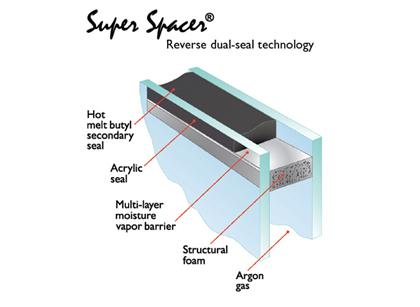The term Low-E gets thrown around quite a bit when talking about replacement windows. People ask for Low-E windows, but the term is a bit vague at best. “Low-E” literally means low emissivity, which in turn means a surface that emits low levels of radiant heat. All surfaces reflect, absorb, and transmit heat. So, a Low-E coating reduces the amount of that heat transfer. When talking about replacement windows the term Low-E really applies to the glass being used.
Low-E glass is made by applying a thin coat of metallic particles to the glass. The most efficient type of Low-E coating is called a “soft coat low-e”. With the soft coat type, the metal is applied to the glass in a vacuum chamber so that an even and consistent coating is achieved. In that type of construction the coated face of the glass is on the inside of a double-pane unit. This way the coating cannot be touched or scratched in any way. The Low-E coating has been made not only to reduce heat transfer, but to also stop UV radiation waves while still letting in visible light.
All Low-E coatings are not the same! Even within the  last few years there have been advancements and improvements to the coatings and the processes. At the base of the matter a good Low-E reflects heat back to the source. So in the summer when the New Mexico sun is beating on our windows the Low-E coating will reflect that heat back to the sun. In the cold months, the heat from your furnace comes up against that Low-E coating and gets reflected back into the house. The glass is designed to keep your home at a constant and comfortable room temperature.
last few years there have been advancements and improvements to the coatings and the processes. At the base of the matter a good Low-E reflects heat back to the source. So in the summer when the New Mexico sun is beating on our windows the Low-E coating will reflect that heat back to the sun. In the cold months, the heat from your furnace comes up against that Low-E coating and gets reflected back into the house. The glass is designed to keep your home at a constant and comfortable room temperature.
Low-E is not the same as tinted glass. Tinted glass blocks only the light that you see, but not the heat or UV waves. Tinted glass has a tendency to get very hot so be careful about where and why you would want it. Tinted glass can also appear to be different colors depending on the size of the window. You use thicker glass on larger units, so they would appear darker than smaller windows next to them. Since Low-E is a coating that is applied to the glass, the appearance will not vary from window to window.
Just keep in mind that when someone says a window is Low-E, they mean that the glass in the window is good at reflecting heat. To see how well a window does this, check the ratings. At Glass-Rite we’re proud to display our ratings and values of our windows because the efficiency of our product is hard to beat! The best way to compare different Low-E glasses is to look at their U-Value and Solar Heat Gain Coefficient numbers. Check out our posting about why you should check NFRC labels to better understand what those numbers really mean!
At Glass-Rite we use a high performance soft  coat Low-E glass, an Argon gas fill, and a warm edge spacer in our double-pane glass units. We are making these glass units here on site at our shop in Albuquerque and they are being sealed at this altitude. That means not only do you get super efficiency, but you also get a glass unit that is guaranteed to never leak or fog up inside the panes. When we put those glass units in our Energy Quest Vinyl window we have some numbers that are tough to beat! Please come and visit us at our factory and showroom to see how these Low-E units are made.
coat Low-E glass, an Argon gas fill, and a warm edge spacer in our double-pane glass units. We are making these glass units here on site at our shop in Albuquerque and they are being sealed at this altitude. That means not only do you get super efficiency, but you also get a glass unit that is guaranteed to never leak or fog up inside the panes. When we put those glass units in our Energy Quest Vinyl window we have some numbers that are tough to beat! Please come and visit us at our factory and showroom to see how these Low-E units are made.

